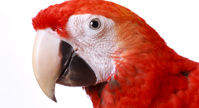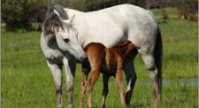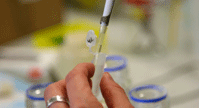K-Locus (Dominant Black)
Description:
 Coat coloration is controlled by several different genes in dogs. The K locus, also known as the dominant black gene, is due to a mutation in a Beta-defensin gene (CBD103). This gene binds proteins and other pigment type cells to produce the different variations of the K locus. This gene occurs in certain breeds and has an important impact on many types of colorations.
Coat coloration is controlled by several different genes in dogs. The K locus, also known as the dominant black gene, is due to a mutation in a Beta-defensin gene (CBD103). This gene binds proteins and other pigment type cells to produce the different variations of the K locus. This gene occurs in certain breeds and has an important impact on many types of colorations.
The K locus is dependent on the E locus. If the E locus genotype is e/e (recessive), the K locus is not expressed. However, if the E locus is coded as E/E or E/e, the K locus is still expressed. To learn more about the E locus, click here.
The “KB” Allele
The dominant black gene consists of three different alleles, or variants. The first allele, which is dominant, is notated as "KB," or dominant black. The dominant black allele is actually a mutation that reduces or eliminates the expression of the agouti gene (A locus). To learn more about the agouti gene, click here. Because this mutation is dominant, a dog only needs to have one copy of the mutation to affect the agouti locus. If a dog is KB/KB or KB/n that means that they will be solid black in color.
The “Kbr” Allele
The second allele is known as the "brindling" allele, and is represented as "Kbr." The Kbr allele is a separate mutation that allows the A locus to be expressed. However, the expression causes a brindling of the agouti patterns. The A locus represents several different colors, such as fawn/sable, tricolor, tan points, or recessive black. The Kbr allele is recessive to the KB allele. This means that if a dog’s genotype is KB/Kbr, they will still be black in color. Kbr is, however, dominant over the third allele, Ky.
The “Ky” Allele
The third allele is represented as "Ky.” This allele allows the agouti gene to be expressed without brindling. If a dog is Ky/Ky at the K locus, the A locus then determines the dog's coat color. The Ky allele is recessive to both KB and Kbr. This means that if the dog has a genotype of KB/Ky or Kbr/Ky, the dog will not express the A locus like a Ky/Ky dog would. A KB dog would be black and the Kbr dog would express a brindled A locus allele.
For example, a dog that is Ay/Ay at the A locus could be fawn/sable if the dog is Ky/Ky. However, if that same dog is KB/KB at the K locus, the A locus expression will be hidden. His coloration will be determined at the B and E loci and there is a good chance the dog will be black. However, if that same dog is Ky/Ky at the K locus, he will then be able to express colorations on the A locus, and will be fawn/sable.
At this time, there is no direct test for the Kbr allele. The allele can generally be inferred through testing for the presence of the dominant black allele, as well as through the phenotypes of the parents and offspring. Testing for the dominant black mutation determines if the dog is able to express the agouti phenotypes (A locus). However, the test is limited in that it will not tell you if the dog will pass on brindle colorations.
K Locus Testing:
Animal Genetics currently offers a test for the K Locus to determine how many copies of the dominant "KB" allele a dog carries. Dogs can be DNA tested at ANY age.
Sample Type:
Animal Genetics accepts buccal swab, blood, and dewclaw samples for testing. Sample collection kits are available and can be ordered at Canine Test Now.
Testing Is Relevant for the Following Breeds:
KB is a critical allele in the formation of black pigment in at least 50 breeds.
Results:
Animal Genetics offers DNA testing for the dominant KB allele. The genetic test verifies the presence of the dominant mutation and presents results as one of the following:
| KB/KB | The dog carries two copies of the dominant "KB" allele. The dog will not have fawn offspring. The dog will always pass on a copy of the "KB" allele to all offspring. |
| KB/n | One copy of the dominant black allele was detected. The agouti phenotype will be altered and in some breeds can result in brindle. The dog could pass on this allele, or either the brindle or fawn allele, to any offspring. |
| n/n | The dog does not carry the dominant black mutation. The dog's coat color will be determined by the agouti gene, and may pass on brindle or non-brindle. |
Submit a Sample for Testing:
To submit a sample for testing please go to Canine Test Now.
To order a sample collection kit please go to Order Sample Collection kits.
Cost per sample is $40.00. Please see our Canine Fee Schedule for all test rates.










